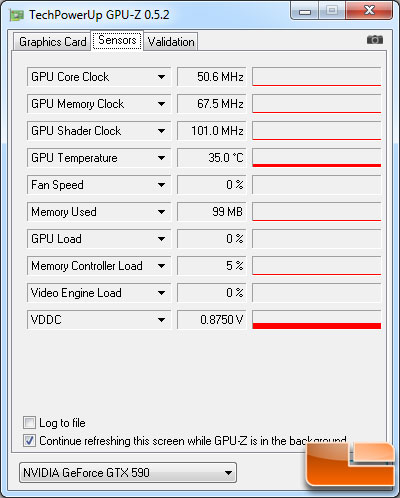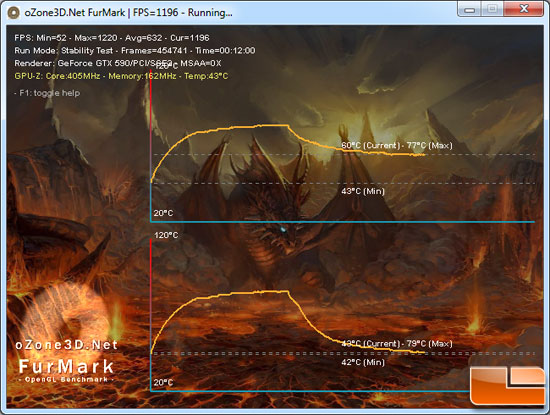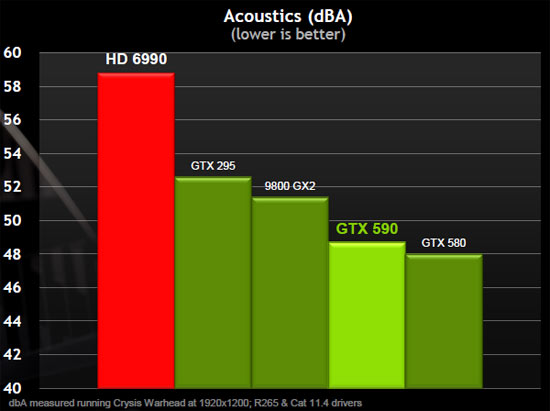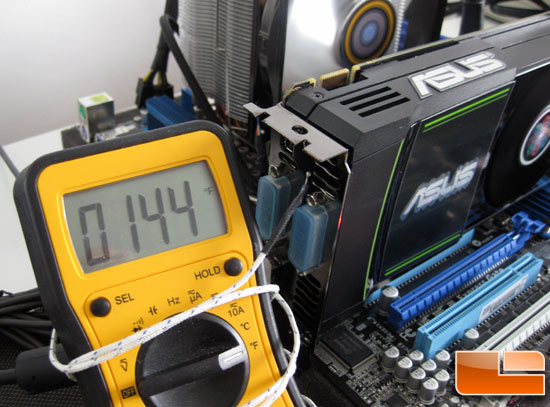ASUS GeForce GTX 590 3GB Video Card Review
Temperature Testing
Since video card temperatures and the heat generated by next-generation cards have become an area of concern among enthusiasts and gamers, we want to take a closer look at how the graphics cards do at idle and under a full load.
ASUS GeForce GTX 590 Video Card Idle Temperature:

As you can see from the screen shot above, the ASUS GeForce GTX590 had power idle states of 50.6MHz on the GPU core clock and 67.5MHz on the memory. We observed the GeForce GTX 590 to idle at 35C in a room with a temperature of 24C.
We fired up FurMark and ran the stability at 640×480, which was enough to put the GPU core at 100% load in order to get the highest load temperature possible. This application also charts the temperature results so you can see how the temperature rises and levels off, which is very nice. The fans on the video card were left on auto during temperature testing. When we hit the space bar to stop the rendering the temperature dropped.
ASUS GeForce GTX 590 Video Card Load Temperature:

The ASUS GeForce GTX 590 peaked at 77 on one core and 79C on the other according to Furmark and that is pretty good for a dual-GPU video card.

We fired up Heaven 2.1 and noticed that in GPU-Z the GPU load was roughly 85% during the benchmark and the temperature peaked at 81C with the fan on auto. Even though the GPU load wasn’t as high as the 91% we saw in Furmark the video card peak temperature was a couple degrees higher.
The sound level wasn’t that bad at idle (40% or 1470RPM) or full load during gaming (49% at 1770RPM). It’s almost a little shocking that as the GPU temperature rose from 35C to 81C the fan speed tables on the GTX590 only increased by 300RPM! It’s no wonder that we were told by NVIDIA that this is the quietest dual-GPU card that they have ever released.

After hearing the card run side-by-side with the AMD Radeon HD 6990 we noticed that the NVIDIA GeForce GTX 590 cooling solution is much quieter. NVIDIA provided the above slide that shows noise levels during gaming on several popular cards. As you can see the GTX590 is just 1dBA louder than the GTX580!

Just for fun we took a look at the exhaust temperatures of the card during game benchmarking and found the card pumping out 144 degrees Fahrenheit (62C) air out the external exhaust ports. Not bad considering what it is, but it was still enough air to heat up our test lab now that the warmer spring weather is here!

Comments are closed.